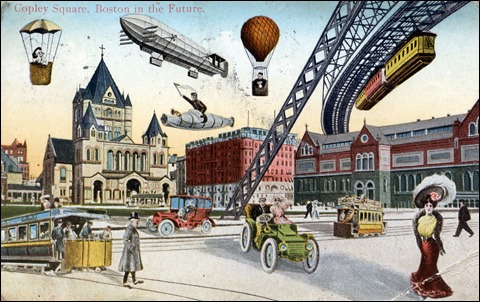
Anyhoo, I want to publish this exerpt from a book on velocipede which is quite fascinating:
"The power and advantages of velocipedes have been well advocated during the past year in the scientific periodicals, and some of the arguments are interesting. The one gentleman points out that "walking requires a tractive force equal to 1-13th of the man's weight. A wheeled vehicle on a gravel road (which is one of the worst) requires 1-16th of the gross weight; on a well-macadamized road about 1-40th; on the best London pavement 1-70th; on well laid flagstones 1-180th; and on a railway 1-224th. If we take a man's expenditure of force in rowing or working a velocipede as equal to 53 foot pounds per second, and 30 miles equal to a day's walking, we shall find that a man weighing 150 pounds on a velocipede weighing 80 pounds (and we should remember that the weight of the best bicycles does not exceed 56 pounds) will travel on a road where the traction is 1-40th from 50 to 60 miles easier than he will walk 30, even if he uses a four-wheeler. On the best London pavement he might travel 90-100 miles, and on a railroad about 270 miles a day."
List of items required to build a bike (6'8" wide when folded, lightest 56 lbs w/out attachment, max speed 20 mph):
1. Boring bar -
(the boring bar can slide in the bar or arbor, to or from each other, to the limit of length of the lugs. The halves are held apart by liners, the whole held by nuts at the ends in usual way. The holes are flanged as shown in the engraving, giving an increased threaded surface, from the usual 1/2-inch to about 7/8 inch. A plug can be taken out and returned any number of times with certainty of being tight.
2. Frame (made of steel tubing)
3. Connections - made of drop forgings
4. Ball bearings
5. Tangent spoke wheels
6. Parts nickeled in bicycle are same
7. Wheel rims
(made of No. 16 gage tire steel beaded outwardly at outer edge, and in at the center, to give the greatest strength possible)
8. 2 Reinforced rail flanges made to M.C.B. standard for front and small auxiliary wheels
*the flange of 24-inch forward wheel can be adjusted with the handle bars by the operator, to run toward or from the rail, thereby making it possible to pass around the sharpest curves and over imperfect or worn frog points at a high rate of speed without danger. Also, when running over straight track the operator can adjust forward wheel so that the flange will run free from the rail, and thus avoid any unnecessary friction.
9. NO RAIL FLANGE FOR REAR WHEEL, it being in line with the forward wheel, frame very rigid, tread sufficiently wide to make derailment impossible.
10. Auxiliary wheel (11-inch diameter), has rail flange, constructed throughout same as larger wheels.
11. 3 (3/16" inch thick, 3"" wide) continuous rubber bands - on tread. (cause car to run noiselessly).
Vision has now expanded to the possibility of steam engines attached to railway velocipede bicycles with hydroelectric power stations for refueling.
Full vision of train station project:
setup bicylery (ala' New Hope/Genesis Bicycles near railroad tracks)
Also Bike shop along Camelback - that I'll be making & manufacturing Rail Velocipede & Guided Natural Tours
1. New Hope Cyclery
2. Genesis Bikes
3. Wheelfine Imports
Must have apartment near track/civilization, ala Cheryl/Ashbury Park.
AWESOME EAST STROUDSBURG COMMUNITY ALLIANCE WEBSITE: KUDOS CHERYL!
Other ideas from the Velocipede Folder, a part of the full Vision for future rail travel in America:
Delaware Canal State Park 11 Lodi Hill Rd. Upper Black Eddy, PA 18972 delawarecanalsp@state.pa.us (from RailTrails PA, but conceivably could transition to a real rail trail).
Another great fact from a pocketbook PA Railtrails:
The original:
The Wilkes-Barre and Eastern Railroad, built in 1893, ran for 62 mountainous miles between Wilkes-Barre and Stroudsburg. It operated as a branch of the Erie Railroad, but was never very successful. After suffering damage in the flood of 1936, the hapless line was abandoned in 1939.
LOCATED NEAR BIG POCONO STATE PARK, THE TRAIL OPENED IN 1954. Only a 1 mile section is open at this time. To reach the trail, take exit 45 from I-80 and head south on Route 715. Turn right onto Railroad Ave. and follow it approximately 1 mile to the trailhead, which is on the right.
LINKS:
http://www.whippanyrailwaymuseum.net/
http://jstor.org/pss/3103532
http://www.railstoparadise.com/
References:
Catton, Theodore. Wonderland: Administrative History of Mt. Rainier National Park
Cox, Thomas R. Mills and Markets. University of Washington
Dilgard, David. Mill Town
Engle, Pearl Tacoma
Felt, Margaret E. The Enterprising Mister Murray. Caxton Publishing (1978).
French, Chauncey D. Railroadman. MacMillan Company (1938).
Friday, Chris. Organizing Asian American Labor. Temple University
Hines, Walker D. War History of American Railroads. Yale University
Holter, Russell and Jesse Clark McAbee. Rails To Paradise: The History of the Tacoma
Hunt, Herbert. History of Tacoma Washington
Ott, John S. The Story of the Tacoma Tacoma
Ranger, Dan. Pacific Coast
Reese, Gary F. Origins of Pierce County Place
Telewski, Frank W. and Scott D. Barrett. Logging Railroads of Weyerhaeuser’s Vail-McDonald Operation. Oso Publishing (2005).
Thompson, Dennis B., et al. The Climax Locomotive. Oso Publishing (2002).
Wood, Charles R. and Dorothy M. Milwaukee Road West Superior
http://velocipedebikeproject.org/news/
http://www.catskillarchive.com/rrextra/odveloc1.Html
http://speeders.rockymountainrailway.com/history.htm
http://www.railbike.com/buying.htm
http://www.lotempiolaw.com/uploads/file/4230046_Convertible_railway_velocipede.pdf
http://www.google.com/patents/US4230046?printsec=abstract&source=gbs_overview_r&cad=0#v=onepage&q&f=false
http://www.montgomerynews.com/articles/2012/01/09/montgomery_life/communities/doc4f0b2476c2bc6339477947.txt
http://www.abandonedrails.com/Pennsylvania
http://www.lotempiolaw.com/uploads/file/4230046_Convertible_railway_velocipede.pdf
http://www.google.com/patents/US4230046?printsec=abstract&source=gbs_overview_r&cad=0#v=onepage&q&f=false
http://www.montgomerynews.com/articles/2012/01/09/montgomery_life/communities/doc4f0b2476c2bc6339477947.txt
http://www.abandonedrails.com/Pennsylvania
Biblio:
No comments:
Post a Comment